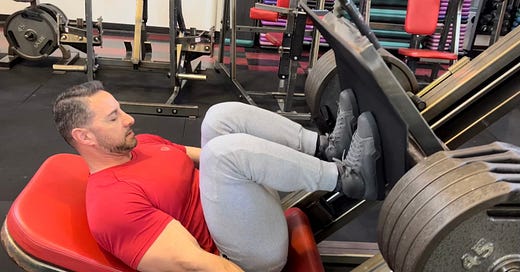Drop Your Feet to Learn How Strong Your Legs Really Are
Subtle adjustments, such as foot placement, can make all the difference
In my last article, I got more specific about workout techniques and shared my preferred rep tempo. In this article, I’m going to stay specific because, again, I’m a big believer that small details can make all the difference in the training game.
Consider something as subtle as foot placement. When I look around the gym, I often see both men and women with impressive amounts of weight on the leg press. Invariably, though, they are using a high foot placement and performing what amounts to half-repetitions. This turns the movement into a middle-of-the-road hamstrings and glute exercise that, in my opinion, doesn’t have a place in a proper leg-training routine. To understand why, we need to first examine the biomechanics of the exercise.
Here’s Professor Brad Schoenfeld, PhD, graduate director of the Human Performance and Fitness program at Lehman College:
The hamstrings carry out two primary functions: knee flexion and hip extension. When you perform a leg press, the hamstrings never really shorten or lengthen much (since the actions are opposing each other at the knee and hip during performance), which ultimately reduces their involvement in the exercise.
Biomechanically, it makes sense that the hamstrings would be more involved when the feet are placed higher on the platform (due to a greater hip extension moment). But ultimately the exercise is more of a quad-dominant movement, regardless.
That last part is key: The leg press is a “quad-dominant movement.” As a result, it offers little effective value to your hamstrings and glutes.
When I explain this to clients, they will sometimes push back. “But I can feel it in my hamstrings and glutes!” they’ll argue. “Plus, I can press more weight!” They’re not wrong. You can definitely press a lot of weight with a high foot placement, and you will also definitely feel the exercise in the muscle groups mentioned when you shift the load in that way. However, there are much better exercises for targeting and developing the hamstrings and glutes, such as leg curls, hip thrusts and back extensions.
More to the point, high foot placement robs you of valuable range of motion through the quads, which also reduces range of motion through the hamstrings. Full range of motion is the key to proper muscle development and gains. Do yourself a favor: Drop the weight in half, drop your feet to the bottom of the plate and shift the load to your quads. But beware: Your ego may become bruised as you get a reality check and see how much you can actually leg press.
Work hard, train smarter!
For Paid Subscribers Only
Click here to check out the Leg Day routine I have several well-trained clients running right now.
Not a paid subscriber? Hit that button below. We publish workouts, videos and other great premium content every week.




